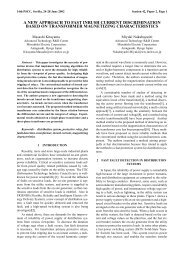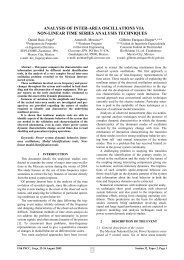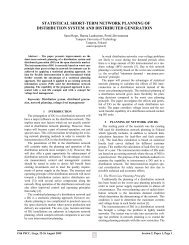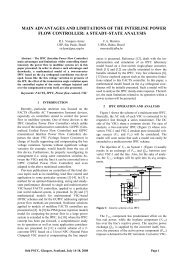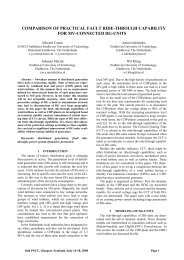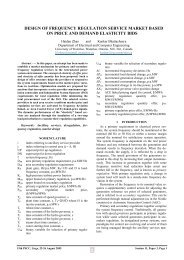Advantages of power system state estimation using Phasor ... - PSCC
Advantages of power system state estimation using Phasor ... - PSCC
Advantages of power system state estimation using Phasor ... - PSCC
Create successful ePaper yourself
Turn your PDF publications into a flip-book with our unique Google optimized e-Paper software.
In this paper, the effect <strong>of</strong> asynchronicity in the measurement<br />
set and <strong>of</strong> additional PMU measurements on the<br />
accuracy <strong>of</strong> the <strong>state</strong> <strong>estimation</strong> is analysed. The first section<br />
describes the measurements used by a <strong>state</strong> estimator.<br />
Subsequently the various <strong>state</strong> estimators are described.<br />
The third section describes the bad data identification<br />
and detection methods. Finally, simulations analysing the<br />
effect <strong>of</strong> time skew errors when <strong>using</strong> a weighted least<br />
squares <strong>state</strong> estimator are discussed.<br />
2 Measurements<br />
The output <strong>of</strong> a <strong>state</strong> estimator is the value <strong>of</strong> the <strong>state</strong><br />
variables at a given time, deduced from a set <strong>of</strong> measurements<br />
taken on the network. If z is the measurement vector<br />
then the model used by <strong>power</strong> <strong>system</strong> <strong>state</strong> <strong>estimation</strong><br />
is [7]:<br />
z = h(x) + e, (1)<br />
where x is the current <strong>state</strong> vector, h is the vector <strong>of</strong><br />
nonlinear measurement functions between x and z and<br />
e is the measurement noise vector. Currently, measurements<br />
are provided by the SCADA <strong>system</strong>. The SCADA<br />
<strong>system</strong> includes three components: the Remote Terminal<br />
Units (RTU), the communication links between RTUs<br />
and master stations or SCADA front end computers. The<br />
main function <strong>of</strong> SCADA is receiving and processing teleinformation,<br />
forming the real-time bases and archives, displaying<br />
the information, documenting the data and finally<br />
solving the dispatching tasks. The RTUs collect various<br />
types <strong>of</strong> measurements from the field and are responsible<br />
for transmitting them to the control center [3]. In this<br />
case the measurements are analog and represent voltage<br />
amplitudes, injected <strong>power</strong> at a node or line <strong>power</strong> flows.<br />
With the advent <strong>of</strong> real-time <strong>Phasor</strong> Measurement Units<br />
(PMU’s), fast transients can be tracked at high sampling<br />
rates. PMUs are actually numeric devices allowing synchronised<br />
phasor measurements. A GPS clock provides a<br />
phase and frequency-locked sample pulse, which permits<br />
synchronisation <strong>of</strong> sampled data taken at any point in the<br />
network. A phasor is a complex number associated with a<br />
sinusoidal wave and the phasors measured by PMUs will<br />
represent voltage at buses and current phasors in lines.<br />
During a dynamic event on the network such as a load or<br />
topology change, time skew errors can occur on measurements<br />
provided by the SCADA <strong>system</strong>. This is because<br />
the snapshot <strong>of</strong> measurements is collected over a few seconds<br />
by the SCADA <strong>system</strong>.<br />
In this paper, the time skew error is simulated as an<br />
asynchronicity rate p between the measurements taken before<br />
and after an event on the network. The asynchronicity<br />
rate p <strong>of</strong> the measurement set defines the number <strong>of</strong> measurements<br />
taken before and after the measurement set and<br />
determines the number <strong>of</strong> measurements taken from each<br />
set as shown in equations 2 and 3.<br />
m 1 = p m tot (2)<br />
m 2 = (1 − p) m tot (3)<br />
where m 1 is the number <strong>of</strong> measurements taken before the<br />
dynamic event, m 2 is the number <strong>of</strong> measurements taken<br />
after the change and m tot is the total number <strong>of</strong> measurements<br />
(m tot = m 1 + m 2 ). Because the measurements<br />
are taken over a period <strong>of</strong> a few seconds, the rate <strong>of</strong> asynchronicity<br />
<strong>of</strong> the measurement set will depend on the time<br />
when the dynamic event takes place. To get an idea <strong>of</strong><br />
the effect asynchronicity can have on the accuracy <strong>of</strong> <strong>state</strong><br />
<strong>estimation</strong> results, the dynamic model <strong>of</strong> the electrical network<br />
is ignored so both <strong>state</strong>s considered are stable.<br />
The measurements should also be well distributed<br />
throughout the network so that there exists a unique solution<br />
to the <strong>state</strong> <strong>estimation</strong> problem. When PMUs provide<br />
the measurements, the observability algorithm [2] can be<br />
used: If a PMU is placed at node v, then all the buses<br />
incident to v are observed.<br />
3 State <strong>estimation</strong><br />
Let us suppose that a vector z <strong>of</strong> m measurements is<br />
available as an input for <strong>state</strong> <strong>estimation</strong> at the control center.<br />
All measurements can be evaluated <strong>using</strong> the <strong>state</strong><br />
variables which are to be determined as in equation 1.<br />
The Weighted Least Squares (WLS) estimator minimises<br />
the performance index or sum <strong>of</strong> the squared residuals<br />
[7, 3]<br />
J(x) = (z − h(x)) T R −1 (z − h(x)), (4)<br />
where z is the input measurement, h(x) is the estimated<br />
measurement and R is the diagonal covariance matrix associating<br />
a variance to each measurement. In other words,<br />
the method ensures that the error between the measurements<br />
and the <strong>estimation</strong>s <strong>of</strong> these measurements when<br />
<strong>using</strong> the <strong>state</strong> variables, is minimised.<br />
Until recently, <strong>state</strong> <strong>estimation</strong> had to rely on nonphasor<br />
measurements. As a result, most work on <strong>state</strong> <strong>estimation</strong><br />
[3, 7] has been about interpreting the classical<br />
measurements made available by the SCADA measurement<br />
<strong>system</strong>. Classical WLS <strong>state</strong> <strong>estimation</strong> involves the<br />
processing <strong>of</strong> those measurements in order to obtain the<br />
best fit or <strong>estimation</strong> for the <strong>state</strong> variables by minimisation<br />
<strong>of</strong> the residuals or <strong>estimation</strong> errors. The main part<br />
is to evaluate the derivatives <strong>of</strong> each measurement with<br />
respect to the <strong>state</strong> variables in order to calculate the jacobian<br />
matrix H.<br />
When solving for x we get<br />
x = ( H T R −1 H ) −1<br />
H T R −1 z. (5)<br />
When <strong>using</strong> classical measurements, the non-linear functions<br />
between measurements and <strong>state</strong> variables have to be<br />
linearised, and the final solution is obtained by iterations.<br />
When <strong>using</strong> PMU measurements, the functions between<br />
measurements and <strong>state</strong> variables are linear so that no iterations<br />
are needed to compute the WLS <strong>state</strong> vector. The<br />
16th <strong>PSCC</strong>, Glasgow, Scotland, July 14-18, 2008 Page 2



